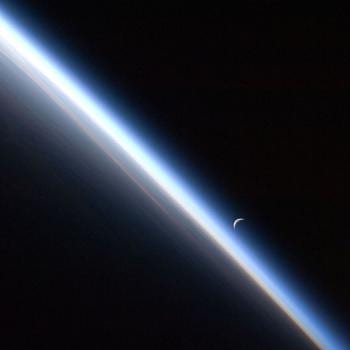
Galaxy NGC 2857 offers us a perfect view of a spiral galaxy.
Public domain image from the European Southern Observatory
The Israeli-American Gerald L. Schroeder earned B.Sc., M.Sc., and Ph.D. degrees from the Massachusetts Institute of Technology (MIT) in nuclear physics and in earth and planetary sciences. He teaches today at Jerusalem’s College of Jewish Studies. The following — which should really be read in conjunction with my earlier entry titled “What’s Needed for Life” — is taken from his book God According to God: A Scientist Discovers We’ve Been Wrong About God All Along (New York: HarperOne, 2009), 78-80:
- The frequency of isolated spiral galaxies is about one galaxy in ten, or 0.1
- The fraction of stars in the galaxy located in a region of low local density of stars, that is, between the spiral arms and far from the galactic center, 0.001.
- The fraction of stars in the galaxy located in a region of high local density of metals, 0.01.
- The fraction of stars with a mass similar to the sun’s mass, 0.05.
- The formation of a stellar system around the remnants of a second- or third-generation supernova within a few billion years of the most recent supernova, 0.1.
- The fraction of planets that are metal-rich planets, 0.5.
- The fraction of planets that have low (relative to asteroid composition) carbon content, 0.3.
- The fraction of planets that have low (relative to asteroid composition) water content, 0.3.
- The fraction of planets that have a molten iron-rich core, 0.2.
- The fraction of planets with mass (gravity) able to hold an oxygen-rich but not hydrogen-rich atmosphere, 0.2.
- The fraction of planets with continent-forming plate tectonics, 0.1.
- The fractionof planets with nearly circular orbit, 0.5.
- The fraction of planets approximately 150 million kilometers from a sun-like star, 0.1.
- The fraction of planetary systems with huge outer planets, 0.01.
- The fraction of planetary systems with no huge inner planets, 0.1.
- The fraction of planets with a period of planetary rotation on the order of days, 0.5.
- The fraction of planets with a moderate tilt to the planet’s axis of rotation, 0.2.
- The fraction of planets with a large moon, 0.05.
Multiplying these admittedly gross, but nonetheless conservative, estimates, which are based on the conditions observed within our life-supporting galaxy and solar system and on our life-nurturing earth, the likelihood of finding anywhere in the entire universe a stellar system with a planet able to support complex intelligent life is one chance in 1018. The estimated number of stars in the entire visible universe is in the order of 1022. This indicates that in the entire universe there may be approximately 104, or 10,000, earthlike planets circling a sunlike star. These 10,000 potentially earthlike planets would be distributed among the 1011, or 100,000,000,000, galaxies in the entire visible universe. That comes out to be one earthlike planet for each 10,000,000 galaxies. The probability that any one galaxy would have more than one life-bearing stellar system is slim indeed.
Of course, this estimate relates only to the possibility of finding conditions that would nurture life once it started. We learn nothing here concerning the properties required for the inception of life. Since we have no knowledge as to how life started on earth, and started remarkably rapidly, there are no data on which to base an estimation that might indicate the likelihood of life originating on any one of those rare life-friendly planets. Considering the uniqueness of our home in space, chances are that we are alone in our galaxy and possibly alone in the universe.
One fact is certain. We live on a very special planet that circles our star in a very special way, in a universe that has all the markings of being the product of design.
Because of statements made in their unique scriptural canon, Latter-day Saints have a more optimistic perspective on the likelihood of extraterrestrial than Dr. Schroeder does. But his comments are nonetheless interesting.












